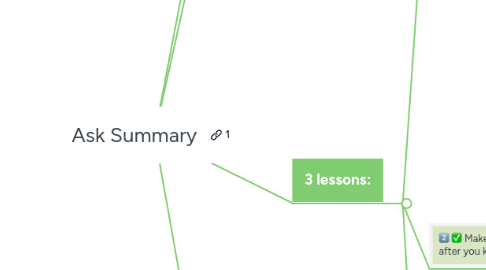
1. 1-Sentence-Summary:
1.1. Ask shows you a method that helps you take the guesswork out of the equation so you can give your customers what they want even if they don’t know what they want.
2. Favorite quote from the author:
2.1. "One of the biggest things I discovered was that I had been taking a "one size fits all" approach to my marketing" - Ryan Levesque
3. 3 lessons:
3.1. Create engaging surveys to segment your audience into buckets.
3.1.1. Make surveys more enticing for the prospects.
3.1.1.1. Begin the journey of your prospects with a deep dive survey to get to know them better.
3.1.1.2. To do that, you must craft the survey in a way that makes people want to respond.
3.1.2. Most people don’t know what they exactly want, but they do know what they don’t want.
3.1.3. Starting with a question like “What’s the biggest challenge you’re struggling with right now?” will make people more likely to want to talk about their problems.
3.1.4. Once they’ve landed on the survey page, you need to design Prospect Self-Discovery Landing Page to increase participation.
3.1.4.1. In these, you start with an intriguing headline and mention the goal of the survey which should evoke interest or curiosity among the prospects.
3.1.4.2. You can also add a short video to make it more engaging.
3.1.4.3. Finally, you can hint your expertise to win your prospects and make them more likely to engage.
3.1.5. For those who respond, collect more information about them to divide them into prospect buckets.
3.1.5.1. An example:
3.2. Make your hyper-relevant sales pitch only after you know who you’re talking to.
3.2.1. Once you hook the prospects, it’s time to do the Micro-Commitment Bucket Survey.
3.2.1.1. Start off with a casual multiple-choice question before you ask more private questions.
3.2.1.2. Avoid the temptation of asking non-relevant questions and only ask questions that will help you refine your segmented buckets.
3.2.2. The next step after collecting enough information and gaining your audience’s trust is to make your sales pitch.
3.2.2.1. This page should have a diagnosis of their problem and the solution to it.
3.2.2.2. You could think of it like a doctor diagnosing disease and then prescribing medicine to combat it.
3.2.2.3. Post a video, talk about the problem, and explain it in more depth.
3.2.2.4. Provide a perfect solution and give a sense of urgency of why it’s important to solve the issue immediately.
3.3. Make the most out of the buyers and non-buyers after making your sales pitch.
3.3.1. Use the Profit Maximization Upsell sequence to continue the relationship with your audience.
3.3.1.1. Right after they make their first purchase, present them with another relevant offer to solve their needs.
3.3.1.2. Now is the best time to do it because they are already in the “buying mode” and they’ve already entered their card information.
3.3.1.3. The offer can either be a discount on a larger purchase, a solution to a problem they may face in the future or a solution to make it easier or faster to get results.
3.3.2. There’s another segment you don’t want to ignore. These are more than 90% of the prospects who don’t buy.
3.3.2.1. Re-engage them by offering them a discount soon after.
3.3.3. But even after that, you’ll have prospects who won’t convert.
3.3.3.1. Give them an opportunity to pivot by applying The Ask Formula all over again.
3.3.4. You can even use the next survey for your buyers to turn them into repeat customers.
